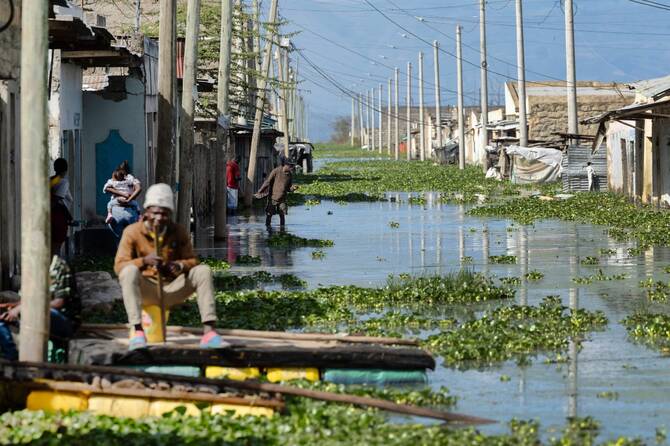
The tourist boats that usually glide across Kenya’s iconic Lake Naivasha have taken on an unexpected new role in recent weeks: rescuing families from flooded homes.
For more than a decade, water levels on the Rift Valley lake have been steadily rising, often spilling over its banks. But residents of Kihoto, a modest lakeside community, say the scale of this year’s flooding is unlike anything they have ever witnessed.
“It hasn’t happened like this before,” said 51-year-old resident Rose Alero, standing in water that reaches her waist.
Local officials report that the lake has surged up to 1.5 kilometres inland—an unprecedented advance. Homes have been submerged, churches destroyed, and entire police stations swallowed by murky floodwaters tangled with floating vegetation.
During one sudden surge, children were forced to escape their classrooms atop improvised rafts.
Mass Displacement and Mounting Health Risks
According to Joyce Cheche, Nakuru County’s head of disaster risk management, as many as 7,000 people have been displaced by the expanding lake, which is also disrupting wildlife habitats and threatening tourism and local businesses.
The county has helped transport affected families and rolled out health interventions, but no financial compensation has been provided so far.
Fear is spreading among workers in the region’s lucrative flower industry—one of Kenya’s major export sectors—who worry about exposure to cholera, landslides, and even encounters with the numerous hippos that inhabit the lake.
“We didn’t see it coming,” Cheche admitted.
Sanitation conditions in Kihoto have deteriorated sharply, with latrines overflowing and illnesses on the rise.
Many residents have lost all their belongings, while others remain stranded in partially submerged homes, hoping the waters recede.
A Complex Mix of Climate, Tectonics, and Human Pressure
Although climate change–driven rainfall has been widely cited as a key factor behind the rising waters—part of a pattern seen across multiple Rift Valley lakes—experts say the causes are more intricate.
Kenyan geologist John Lagat, a regional manager at the Geothermal Development Corporation, explains that tectonic activity plays a major role. The lakes lie along a vast geological fault, and shifts in the Earth’s crust have gradually blocked underground outlets that once drained excess water.
Historical accounts show that Lake Naivasha was even larger when British settlers arrived in the late 19th century. By 1921, tectonic changes had shrunk it dramatically to about one kilometre in diameter. Now, with outflows increasingly sealed and rainfall intensifying, the lake is expanding once again.
Lagat notes that population growth and land degradation are also contributing significantly to the crisis.
An Uncertain Future
Back in her flooded home, Alero worries about what the next rainy season might bring.
“We are very worried,” she said. “We can’t tell what will happen.”
As Lake Naivasha continues to rise—at nearly one metre per day, according to local estimates—thousands of families remain in limbo, living with uncertainty in a disaster whose full scale may yet unfold.



